Nuln Oil and Games Workshop Contrast paints are excellent ways to boost the perceived quality of our tabletop miniatures but they are on the expensive side, especially when we have a lot of terrain to build.
Can we DIY a cheaper version, but get close to the results we have come to expect from Citadel paints?
Can you really make contrast paint? Turns out, yes!
There are a few options for how to make contrast paints or home-make Nuln Oil, from the least expensive through to the most expensive (but still not as expensive as buying tiny hobby store pots). Personally, I am not a big fan of oil paint or spirits/solvents, so I will leave the options involving those to other people.
For Making Contrast Paints or Washes You Will Need:
- Pigment – The stuff that actually does the shading. For Nuln oil we need a black pigment, and a DIY Agrax Earthshade would be brown. Of course, your contrast paints will be whichever colour you are going for. Each pigment, even within the same range, will need testing to see how much and how little you need. Some people use a measuring cup, a syringe or a pipette, I eyeball it and use a brush to test on a piece of waste plastic. You do you.
- Medium – Medium in the paint world is just paint without pigment. It is the delivery system for the paint, and how the paint gets onto your project. More medium means more dilute, less medium means more pigment per brush stroke. The thinner your final mix, the more like a wash/shade it will be rather than a contrast paint or even a base coat. Experiment and you might end up buying fewer pre-mixed paints for all your hobby needs.
- Flow-aid – With shades/washes and contrast, you want the pigment to mostly find the crevices and details. The idea is your raised areas become lighter and the recesses become darker. To assist this we use a flow aid, which breaks the surface tension of the liquid and helps it roam around via a kind of spooky capillary action.
- Water – Water thins down the mix even further. Some people mix in solvents etc. at this stage but I try to avoid anything that sets my already hyper-sensitive sinuses off any more than necessary. That said, I live in Alberta which is dry AF. I don’t need anything to encourage my paints to evaporate, in fact, I have the opposite problem.
How you arrive at those ingredients, you need the recipe, and the quantity and quality of each, is how you vary the price and outcome.
Here are my two main options and where I would use them.
1. How to Make Nuln Oil Cheaply: Bulk Washes and DIY Contrast Paint
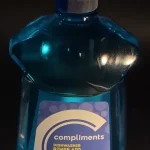
For massive terrain, where you basically need a bucket of this stuff, you are going to want to grab
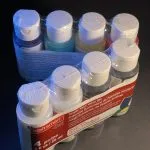
- Cheap craft paint – Other pigments will do, try them out. Stick to acrylic, or water-based though. I would hesitate to use paints that are, say, intended for painting your garage door, but you do you. You’re going to need black at minimum, then I would suggest white and primary colours.
- (Optional) Multi-surface polish – Lots of household polish is very chemically similar to highly diluted acrylic medium. The only problem is the glossiness, but you might be ok with that. Personally, I use actual medium just because I haven’t found a polish without extra “stuff” and a super, super glossy finish. Let me know if you are in Canada and you find a perfect substitute, please!
- Household flow aid – Dish soap, dishwasher rinse aid, etc., all work on a similar principle to actual flow aid. They break up the surface tension of liquids. You don’t even need expensive stuff, but just don’t put it in your eyes or mouth.
- Tap water – Unless you need to store your wash for a long time or have tiny, tiny details, you will likely be 100% fine using tap water for your bulk washes. If you use the multi-surface polish, you might not even need to add water. Try it and see.
This is not going to sit on your shelf for months and be project-ready, but it is a very cheap DIY contrast paint recipe and you might already have the stuff around the house.
2. Higher Quality DIY Nuln Oil/Agrax Earthshade/DIY Contrast Paint Recipe
When I want to be a bit more quality-conscious I up my budget a tiny bit and go for a contrast paint or Nuln Oil recipe that uses some art store ingredients. You will still save a bunch of money but it does cost more than the household cleaning supplies.
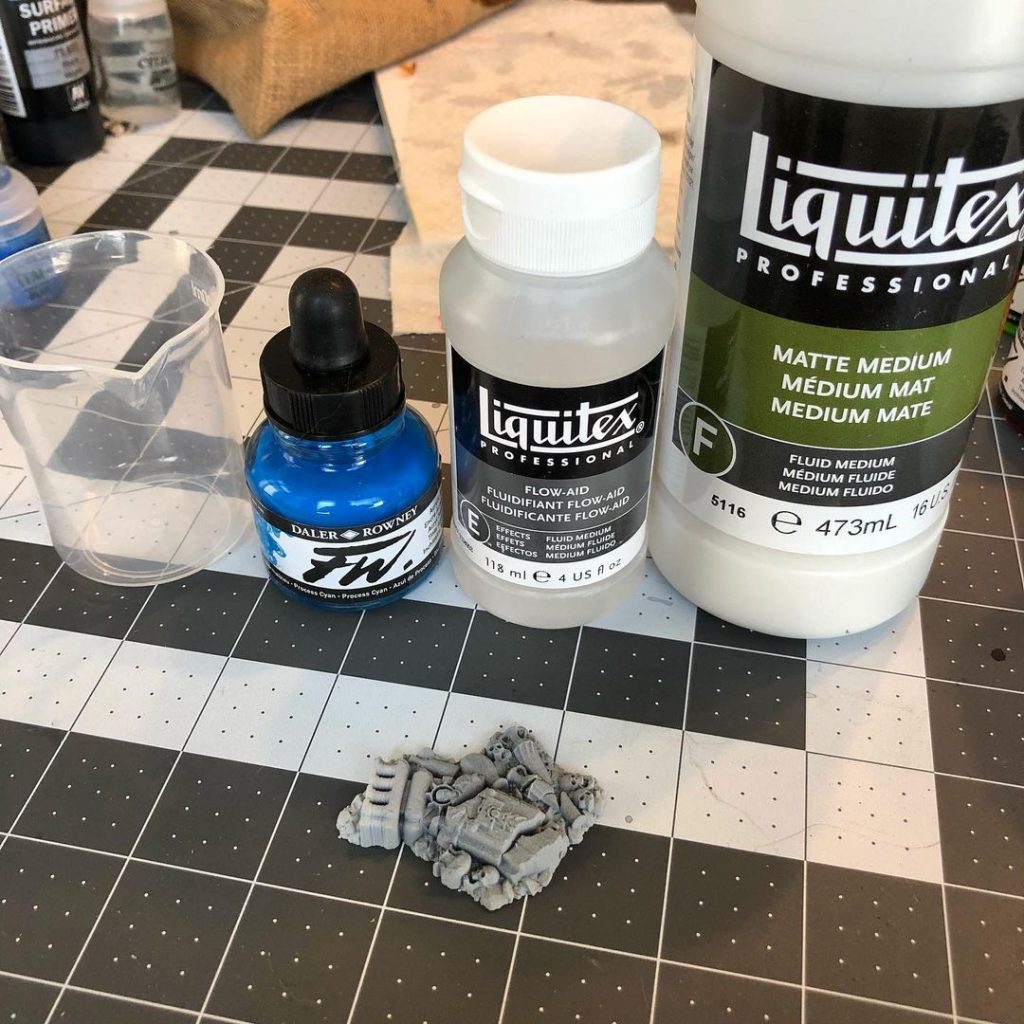
The great thing about making your own using proper art supplies is you can maintain a high standard, but have exactly what your project needs. Plus, you don’t need to shop around for every variation of every colour imaginable – you can keep your paint collection just to the exotic paints, or the options you need the most.
Make Homemade Contrast Paint & Home Made Nuln Oil Ingredients
For miniatures, you are going to be making “espresso shot glass” quantities to start with. Determine your ratios then scale up. Try a few drops of the ingredient then test with a brush and some scrap material or your palette.
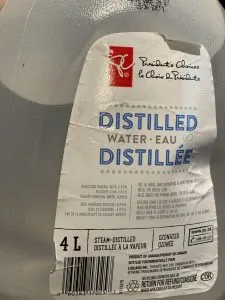
- Acrylic Ink – Acrylic Ink is a highly concentrated liquid pigment. Perfect for our purposes. Note you want acrylic ink, not oil or alcohol-based for this. Again, you’re going to need black at minimum for Nuln Oil, and of course, a brown if you want to replicate Agrax Earthshade, but you can mix your own colours and shades with black, white, and primary colours. Around 2-3 drops of black is enough for a pretty dark miniature wash, other colours need double that or more.
- Matte medium – Again, you want acrylic matte medium. Medium comes in all kinds of finishes, from matte to glossy. If you can’t find matte no worries, you can always spray the finished project with a matte varnish, but it will impact the flow of your paint. For a small amount to use on a mini, start with around 10 drops. Like a teaspoonful.
- Art/Airbrush flow aid – The proper flow aid from art stores will often be right near the medium, or you will find it with the airbrushes and accessories. Unlike the dishwasher stuff, you are mainly getting actual flow aid in these bottles but you pay a lot extra for it. A couple of drops work amazingly, I usually put 4 or 5 drops of actual flow aid, you will need to experiment with your substitute.
- Distilled or otherwise purified water – As mentioned above, I live in Alberta in the foothills of the Rockies. Our water tastes of mountains. It’s so hard it participates in fight club every weekend. Your tap water might be super pure already, or you might have a water filter, but if in doubt buy some water. You want the stuff that is meant for your clothes iron, humidifier, etc. Start with around 50% of your mix being water.
Mixing and Storing the Paints
You will need something to mix the paint, anything from a measuring cup through to a red solo cup, and a stirrer. For a stirrer, you can use a coffee stirrer, a piece of stick, or an old brush, but ensure the stirrer doesn’t leave any residue or oils.
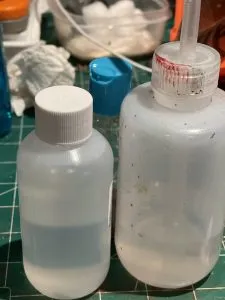
For longer-term storage, you can get bottles from the craft and dollar store, or you can collect and thoroughly clean out the containers you come across as you use up the contents. If you do use solvents, ensure the containers don’t react negatively to those solvents – I have heard horror stories of people using plastic containers with their acetone-diluted mixtures.
Empty dropper bottles are an expensive but convenient solution for tiny, tiny amounts.
Just ensure whatever you use has a good seal.

 What is Zenithal Primer?
What is Zenithal Primer?